
Checkers, also known as draughts, is a group of strategy board games for two players which involve diagonal moves of uniform game pieces and mandatory captures by jumping over opponent pieces. Checkers is developed from alquerque. The term "checkers" derives from the checkered board which the game is played on, whereas "draughts" derives from the verb "to draw" or "to move".
Grand Chess is a large-board chess variant invented by Dutch games designer Christian Freeling in 1984. It is played on a 10×10 board, with each side having two additional pawns and two new pieces: the marshal and the cardinal.

Epaminondas is a strategy board game invented by Robert Abbott in 1975. The game is named after the Theban general Epaminondas, known for the use of phalanx strategy in combat. The concept of the phalanx is integral to the game.
Breakthrough is an abstract strategy board game invented by Dan Troyka in 2000 and made available as a Zillions of Games file (ZRF). It won the 2001 8x8 Game Design Competition, even though the game was originally played on a 7x7 board, as it is trivially extensible to larger board sizes.

Havannah is a two-player abstract strategy board game invented by Christian Freeling. It belongs to the family of games commonly called connection games; its relatives include Hex and TwixT. Havannah has "a sophisticated and varied strategy" and is best played on a base-10 hexagonal board, 10 hex cells to a side.
Gonnect is a strategy board game for two players invented by João Pedro Neto in 2000. The game is played with standard Go equipment and basically uses the same rules as Go, however the goal of the game is to construct a group that connects any two opposite sides.
Martian Chess is an abstract strategy game for two or four players invented by Andrew Looney in 1999. It is played with Icehouse pyramids on a chessboard. To play with a number of players other than two or four, a non-Euclidean surface can be tiled to produce a board of the required size, allowing up to six players.

Janggi, sometimes called Korean chess, is a strategy board game popular on the Korean Peninsula. The game was derived from xiangqi, and is very similar to it, including the starting position of some of the pieces, and the 9×10 gameboard, but without the xiangqi "river" dividing the board horizontally in the middle.
Entropy is an abstract strategy board game for two players designed by Eric Solomon in 1977. The game is "based on the eternal conflict in the universe between order and chaos [...] One player is Order, the other Chaos. Order is trying to make patterns vertically and horizontally. Chaos is trying to prevent this." The game originally employed a 5×5 gameboard, but in 2000 a 7x7 board was introduced to allow deeper strategies.

Christian Freeling is a Dutch game designer and inventor of abstract strategy games, notably Dameo, Grand Chess, Havannah, and Hexdame.
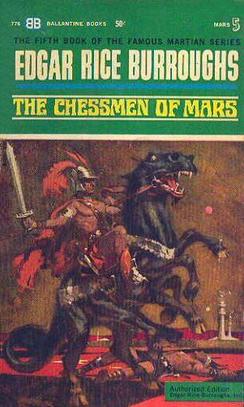
Jetan, also known as Martian chess, is a chess variant first published in 1922. It was created by Edgar Rice Burroughs as a game played on Barsoom, his fictional version of Mars. The game was introduced in The Chessmen of Mars, the fifth book in the Barsoom series. Its rules are described in Chapter 2 and in the Appendix of the book, with an actual game partly described in Chapter 17.

Surakarta is a little-known Indonesian strategy board game for two players, named after the ancient city of Surakarta in central Java. The game features an unusual method of capture which is "possibly unique" and "not known to exist in any other recorded board game". Little is known about its history.
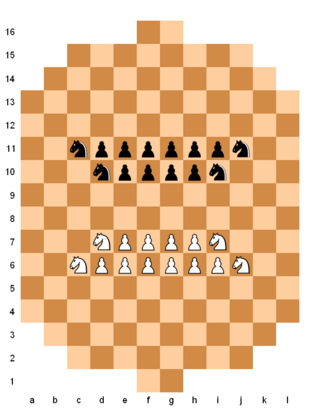
Camelot is a strategy board game for two players. It was invented by George S. Parker late in the 19th century, and was one of the first games published by Parker Brothers, originally under the name Chivalry.
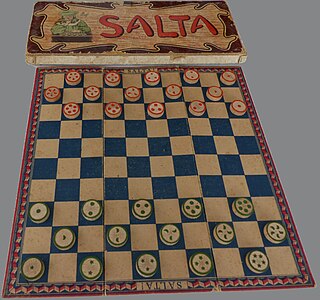
Salta is two-player abstract strategy board game invented by Konrad Heinrich Büttgenbach in 1899 in Germany. Büttgenbach (1870–1939) was born in Heerdt, near Düsseldorf, Germany. The game attained its highest popularity in the early 1900s before World War I especially in France and Germany. The World Trade Fair of 1900 in Paris exhibited a Salta board made of mahogany with golden counters adorned with more than 5,000 diamonds. Famous players were the US chess master Frank Marshall, the German World Chess Champion Emanuel Lasker, and the French actress Sarah Bernhardt.
A connection game is a type of abstract strategy game in which players attempt to complete a specific type of connection with their pieces. This could involve forming a path between two or more endpoints, completing a closed loop, or connecting all of one's pieces so they are adjacent to each other. Connection games typically have simple rules, but complex strategies. They have minimal components and may be played as board games, computer games, or even paper-and-pencil games.
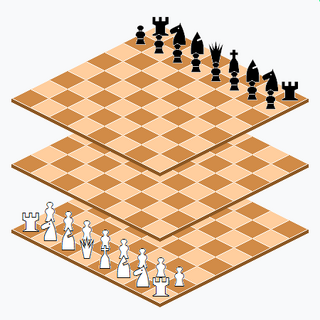
Millennium 3D chess is a three-dimensional chess variant created by William L. d'Agostino in 2001. It employs three vertically stacked 8×8 boards, with each player controlling a standard set of chess pieces. The inventor describes his objective as "extending the traditional chess game into a multilevel environment without distorting the basic game."
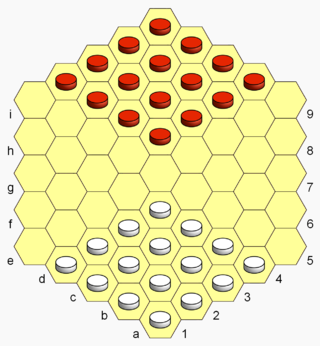
Hexdame is a strategy board game for two players invented by Christian Freeling in 1979. The game is a literal adaptation of the game international draughts to a hexagonal gameboard.

Dameo is an abstract strategy board game for two players invented by Christian Freeling in 2000. It is a variant of the game draughts and is played on an 8×8 checkered gameboard.

Hostage chess is a chess variant invented by John A. Leslie in 1997. Captured pieces are not eliminated from the game but can reenter active play through drops, similar to shogi. Unlike shogi, the piece a player may drop is one of their own pieces previously captured by the opponent. In exchange, the player returns a previously captured enemy piece which the opponent may drop on a future turn. This is the characteristic feature of the game.

Diamond is a two-player abstract strategy board game invented by Larry Back. The invention was inspired by the game Kensington, which uses a similar board pattern and game objective. Rules for Diamond were conceived in 1985 and finalized in 1994. Diamond introduces a new board geometry and neutral pieces, with the aim of enhancing the game dynamic and lowering the potential for draws.















